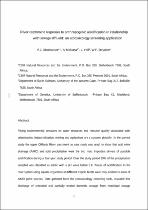 ResearchSpace
ResearchSpace
River catchment responses to anthropogenic acidification in relationship with sewage effluent: An ecotoxicology screening application
JavaScript is disabled for your browser. Some features of this site may not work without it.
- ResearchSpace
- →
- Research Publications/Outputs
- →
- Journal Articles
- →
- View Item
| dc.contributor.author |
Oberholster, Paul J

|
|
| dc.contributor.author |
Botha, A-M

|
|
| dc.contributor.author |
Hill, Liesl

|
|
| dc.contributor.author |
Strydom, Wilma F

|
|
| dc.date.accessioned | 2018-07-31T09:36:13Z | |
| dc.date.available | 2018-07-31T09:36:13Z | |
| dc.date.issued | 2017-12 | |
| dc.identifier.citation | Oberholster, P.J., Botha, A-M., Hill, L., and Strydom, W.F. 2017. River catchment responses to anthropogenic acidification in relationship with sewage effluent: An ecotoxicology screening application. Chemosphere, vol 189, pp 407-417 | en_US |
| dc.identifier.issn | 0045-6535 | |
| dc.identifier.issn | 1879-1298 | |
| dc.identifier.uri | https://www.sciencedirect.com/science/article/pii/S0045653517314972?via%3Dihub | |
| dc.identifier.uri | http://hdl.handle.net/10204/10336 | |
| dc.description | Copyright: 2017. Elsevier. Due to copyright restrictions, the attached PDF file only contains the abstract of the full text item. For access to the full text item, please consult the publisher's website. The definitive version of the work is published in Chemosphere, vol 189, pp 407-417 | en_US |
| dc.description.abstract | Rising environmental pressures on water resources and resource quality associated with urbanisation, industrialisation, mining and agriculture are a global concern. In the current study the upper Olifants River catchment as case study was used, to show that acid mine drainage (AMD) and acid precipitation were the two most important drivers of possible acidification during a four-year study period. Over the study period 59% of the precipitation sampled was classified as acidic with a pH value below 5.6. Traces of acidification in the river system using aquatic organisms at different trophic levels were only evident in areas of AMD point sources. Data gathered from the ecotoxicology screening tools, revealed that discharge of untreated and partially treated domestic sewage from municipal sewage treatment works and informal housing partially mitigate any traces of acidification by AMD and acid precipitation in the main stem of the upper Olifants River. The outcome of the study using phytoplankton and macroinvertebrates as indicator organisms revealed that the high loads of sewage effluent might have played a major role in the neutralization of acidic surface water conditions caused by AMD and acid precipitation. Although previous multiestage and microcosm studies confirmed the decrease in acidity and metals concentrations by municipal wastewater, the current study is the first to provide supportive evidence of this co-attenuation on catchment scale. These findings are important for integrated water resource management on catchment level, especially in river systems with a complex mixture of pollutants. | en_US |
| dc.language.iso | en | en_US |
| dc.publisher | Elsevier | en_US |
| dc.relation.ispartofseries | Workflow;21167 | |
| dc.subject | Acid mine drainage | en_US |
| dc.subject | AMD | en_US |
| dc.subject | Acid precipitation | en_US |
| dc.subject | Neutralization capacity | en_US |
| dc.subject | Sewage effluent | en_US |
| dc.title | River catchment responses to anthropogenic acidification in relationship with sewage effluent: An ecotoxicology screening application | en_US |
| dc.type | Article | en_US |
| dc.identifier.apacitation | Oberholster, P. J., Botha, A., Hill, L., & Strydom, W. F. (2017). River catchment responses to anthropogenic acidification in relationship with sewage effluent: An ecotoxicology screening application. http://hdl.handle.net/10204/10336 | en_ZA |
| dc.identifier.chicagocitation | Oberholster, Paul J, A-M Botha, Liesl Hill, and Wilma F Strydom "River catchment responses to anthropogenic acidification in relationship with sewage effluent: An ecotoxicology screening application." (2017) http://hdl.handle.net/10204/10336 | en_ZA |
| dc.identifier.vancouvercitation | Oberholster PJ, Botha A, Hill L, Strydom WF. River catchment responses to anthropogenic acidification in relationship with sewage effluent: An ecotoxicology screening application. 2017; http://hdl.handle.net/10204/10336. | en_ZA |
| dc.identifier.ris | TY - Article AU - Oberholster, Paul J AU - Botha, A-M AU - Hill, Liesl AU - Strydom, Wilma F AB - Rising environmental pressures on water resources and resource quality associated with urbanisation, industrialisation, mining and agriculture are a global concern. In the current study the upper Olifants River catchment as case study was used, to show that acid mine drainage (AMD) and acid precipitation were the two most important drivers of possible acidification during a four-year study period. Over the study period 59% of the precipitation sampled was classified as acidic with a pH value below 5.6. Traces of acidification in the river system using aquatic organisms at different trophic levels were only evident in areas of AMD point sources. Data gathered from the ecotoxicology screening tools, revealed that discharge of untreated and partially treated domestic sewage from municipal sewage treatment works and informal housing partially mitigate any traces of acidification by AMD and acid precipitation in the main stem of the upper Olifants River. The outcome of the study using phytoplankton and macroinvertebrates as indicator organisms revealed that the high loads of sewage effluent might have played a major role in the neutralization of acidic surface water conditions caused by AMD and acid precipitation. Although previous multiestage and microcosm studies confirmed the decrease in acidity and metals concentrations by municipal wastewater, the current study is the first to provide supportive evidence of this co-attenuation on catchment scale. These findings are important for integrated water resource management on catchment level, especially in river systems with a complex mixture of pollutants. DA - 2017-12 DB - ResearchSpace DP - CSIR KW - Acid mine drainage KW - AMD KW - Acid precipitation KW - Neutralization capacity KW - Sewage effluent LK - https://researchspace.csir.co.za PY - 2017 SM - 0045-6535 SM - 1879-1298 T1 - River catchment responses to anthropogenic acidification in relationship with sewage effluent: An ecotoxicology screening application TI - River catchment responses to anthropogenic acidification in relationship with sewage effluent: An ecotoxicology screening application UR - http://hdl.handle.net/10204/10336 ER - | en_ZA |





